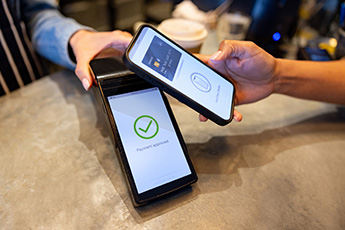Originally published on February 15, 2023:
Chances are that, even today, you know of at least one or two businesses that are still cash only. They are few and far between, but they exist: that small, locally-owned food stand, the specialty grocery store that’s family-owned, the street vendor that sells fruit, or ice cream, or a single specialty. As we collectively become more cashless, however, it’s getting more difficult for those small business owners to operate with cash only while staying competitive.It might be said that the US is headed toward a cashless society. Some small businesses have even put up signs saying that they no longer accept cash, another factor that’s driving this change. Cash payments can take longer, limit potential sales, and open up businesses to the possibility of an audit. Grocery stores and larger retail stores have more self-checkout registers, and although those registers can take cash, customers typically use them for card-based transactions. Many community financial institutions (CFIs) are in the same boat, trying to embrace tech and digital payments, while still acknowledging that not all Americans are ready to bid goodbye to cash just yet.Cards or cash?
As mobile payment apps continue to gain popularity, the trend is certainly away from cash. In August, Gallup found that 60% of people said they make just a few or no purchases with cash, double the number from 5Ys ago. Just 13% said that they make all or most of their purchases with cash — a number that has been slashed in half from the reported 28% 5Ys ago.A closer look at the numbers reveals demographic differences between those who use cash more often and those who don’t. A little over a fifth of people who live in households with annual incomes of less than $40K make most or all of their purchases in cash. In households with annual incomes between $40K and $100K, 14% make most or all their purchases in cash. Just 5% of those with incomes of more than $100K favor cash for their transactions.All told, 73% of higher-income consumers used cash sparingly, yet only 49% of lower-income Americans followed the same trend. About 34% of American households have annual incomes over $100K, so about half of the 66% majority use cash more often than not. Millions of people do still prefer cash, though the number of people who trend toward cash transactions is gradually decreasing.People like having cash as an option.
Even those who handle most of their spending via card transactions report that they like the option of making some purchases with cash. A majority (56%) prefer to have cash with them when they leave home, a number that has increased by 2% since 2016.“People aren’t entirely comfortable getting rid of cash as a payment option. There are still some situations or circumstances they encounter, or can think of, in which they would like the flexibility of paying with cash,” says Gallup senior editor Jeff Jones. Very few people actually want to see the US become a cashless society and prefer having options, to the point where 62% of people are totally against it, according to Civic Source.Banks need to straddle the cash and digital worlds.Financial institutions would undoubtedly benefit from a cashless society. They could continue earning transaction fees and could do away with ATMs and their constant need for service.
But that’s probably not the world that’s coming — not anytime soon, anyway. To continue serving their customers and competing with fintechs, CFIs will need advanced digital capabilities and a willingness to accommodate those who prefer cash transactions.To support customers who go cashless, this might mean partnering with fintechs or other firms to increase technical capabilities for digital financial transactions, or industry-specific software for business customers. To aid customers who prefer cash, CFIs should continue to provide amenities like drive-thru branch support for cash transactions and 24-hour ATM service.Though a cashless society may eventually come, it isn’t in a huge hurry. The most important step for CFIs right now is to cater to all of the transaction types that their customer demographics prefer in order to provide well-rounded services that address the needs of all customers in the meantime.
Chances are that, even today, you know of at least one or two businesses that are still cash only. They are few and far between, but they exist: that small, locally-owned food stand, the specialty grocery store that’s family-owned, the street vendor that sells fruit, or ice cream, or a single specialty. As we collectively become more cashless, however, it’s getting more difficult for those small business owners to operate with cash only while staying competitive.It might be said that the US is headed toward a cashless society. Some small businesses have even put up signs saying that they no longer accept cash, another factor that’s driving this change. Cash payments can take longer, limit potential sales, and open up businesses to the possibility of an audit. Grocery stores and larger retail stores have more self-checkout registers, and although those registers can take cash, customers typically use them for card-based transactions. Many community financial institutions (CFIs) are in the same boat, trying to embrace tech and digital payments, while still acknowledging that not all Americans are ready to bid goodbye to cash just yet.Cards or cash?
As mobile payment apps continue to gain popularity, the trend is certainly away from cash. In August, Gallup found that 60% of people said they make just a few or no purchases with cash, double the number from 5Ys ago. Just 13% said that they make all or most of their purchases with cash — a number that has been slashed in half from the reported 28% 5Ys ago.A closer look at the numbers reveals demographic differences between those who use cash more often and those who don’t. A little over a fifth of people who live in households with annual incomes of less than $40K make most or all of their purchases in cash. In households with annual incomes between $40K and $100K, 14% make most or all their purchases in cash. Just 5% of those with incomes of more than $100K favor cash for their transactions.All told, 73% of higher-income consumers used cash sparingly, yet only 49% of lower-income Americans followed the same trend. About 34% of American households have annual incomes over $100K, so about half of the 66% majority use cash more often than not. Millions of people do still prefer cash, though the number of people who trend toward cash transactions is gradually decreasing.People like having cash as an option.
Even those who handle most of their spending via card transactions report that they like the option of making some purchases with cash. A majority (56%) prefer to have cash with them when they leave home, a number that has increased by 2% since 2016.“People aren’t entirely comfortable getting rid of cash as a payment option. There are still some situations or circumstances they encounter, or can think of, in which they would like the flexibility of paying with cash,” says Gallup senior editor Jeff Jones. Very few people actually want to see the US become a cashless society and prefer having options, to the point where 62% of people are totally against it, according to Civic Source.Banks need to straddle the cash and digital worlds.Financial institutions would undoubtedly benefit from a cashless society. They could continue earning transaction fees and could do away with ATMs and their constant need for service.
But that’s probably not the world that’s coming — not anytime soon, anyway. To continue serving their customers and competing with fintechs, CFIs will need advanced digital capabilities and a willingness to accommodate those who prefer cash transactions.To support customers who go cashless, this might mean partnering with fintechs or other firms to increase technical capabilities for digital financial transactions, or industry-specific software for business customers. To aid customers who prefer cash, CFIs should continue to provide amenities like drive-thru branch support for cash transactions and 24-hour ATM service.Though a cashless society may eventually come, it isn’t in a huge hurry. The most important step for CFIs right now is to cater to all of the transaction types that their customer demographics prefer in order to provide well-rounded services that address the needs of all customers in the meantime.




